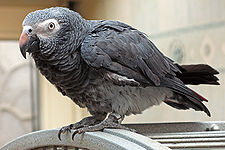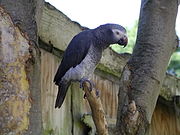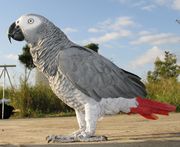
African Grey Parrot
Background to the schools Wikipedia
SOS Children made this Wikipedia selection alongside other schools resources. Click here for more information on SOS Children.
| African Grey Parrot | |
|---|---|
| 225px | |
| Congo African Grey Parrot | |
 |
|
| Timneh African Grey Parrot | |
| Conservation status | |
|
Near Threatened ( IUCN 3.1) |
|
| Scientific classification | |
| Kingdom: | Animalia |
| Phylum: | Chordata |
| Class: | Aves |
| Order: | Psittaciformes |
| Family: | Psittacidae |
| Tribe: | Psittacini |
| Genus: | Psittacus Linnaeus, 1758 |
| Species: | P. erithacus |
| Binomial name | |
| Psittacus erithacus Linnaeus, 1758 |
|
| Subspecies | |
|
|
The African Grey Parrot (Psittacus erithacus) is a medium-sized parrot of the genus Psittacus, endemic to primary and secondary rainforest of West and Central Africa, and is one of the most intelligent birds. They feed primarily on nuts and fruits, supplemented by leafy matter.
There are two subspecies; the Congo African Grey Parrot and the slightly smaller Timneh African Grey Parrot. As their names imply, both subspecies are predominantly grey. They have dark grey wings, and a pale-grey rump. A featherless rim of skin around the eyes is whitish to light grey. The head and neck feathers have paler margins, giving that part of the body a scalloped appearance. The Congo African Grey has a red tail and the Timneh African Grey has a dark-maroon tail.
The African Grey Parrot is popular as a pet or companion parrot, especially the Congo African Grey Parrot, partly because of its ability to imitate speech. The African Grey Parrot is listed on CITES appendix II which restricts trade of wild caught species, because wild populations can not sustain trapping for the pet trade.
Taxonomy and systematics
The African Grey Parrot was one of the many species originally described by Linnaeus in his 18th century work, Systema Naturae, and it still bears its original name of Psittacus erithacus. It is the only currently accepted species of the genus Psittacus. The generic name is derived from Ancient Greek psittakos (ψιττακος), "parrot".
There are two subspecies universally accepted:
- Congo African Grey Parrot, (Psittacus erithacus erithacus):
This is the dominant subspecies, larger than the Timneh being about 33 cm (13 in) long, with light grey feathers, cherry red tails, and an all black beak. Immature birds of this subspecies have tails with a darker, duller red towards the tip (Juniper and Parr 1999) until their first moult which occurs within 18 months of age. These birds also initially have grey irises which change to a pale yellow colour by the time the bird is a year old. The Congo grey parrot is found on the islands of Príncipe and Bioko and is distributed from south-eastern Ivory Coast to Western Kenya, Northwest Tanzania, Southern Democratic Republic of the Congo (DRC) and Northern Angola. In aviculture, it is often called a "CAG". - Timneh African Grey Parrot, (Psittacus erithacus timneh):
These are smaller in size, have a darker charcoal grey coloring, a darker maroon tail, and a light, horn-colored area to part of the upper mandible. The timneh grey parrot is endemic to the western parts of the moist Upper Guinea forests and bordering savannas of West Africa from Guinea-Bissau, Sierra Leone and Southern Mali east to at least 70 km (43 mi) east of the Bandama River in Ivory Coast. In aviculture, it is often called a "TAG".
Some aviculturalists recognize a third and even a fourth subspecies, but these are not distinguishable in scientific studies.
The "Ghana African Grey", formerly recognized as subspecies Psittacus erithacus princeps, is described as similar to the Congo African Greys, but darker and slightly smaller which originates from Fernando Po and Principé Islands.
The "Cameroon African Grey", most often referred to as "the big silvers", is supposedly a larger and lighter form which actually has its origin in birds not from Cameroon but from today's Democratic Republic of the Congo.
Mimicry and intelligence
While comparative judgements of animal intelligence are always very difficult to make objectively, Psittaciformes are generally regarded as being the most intelligent of birds. African grey parrots are particularly noted for their cognitive abilities, believed to have evolved as a consequence of their history of cooperative feeding as largely tree-dwelling birds in central Africa.
Irene Pepperberg's extensive research with captive African greys, especially the one known as Alex, have provided evidence that these parrots are capable of associating human words with their meanings, at least to some extent, though these conclusions are disputed. Ambitious claims of language use have been made for another African grey, N'kisi, who has a vocabulary of around a thousand words and speaks in sentences. Although there exists a great deal of debate as to just how well these birds actually understand the meaning of the words they speak, there is little doubt that Greys and other parrots (especially macaws and cockatoos), along with corvines (crows, ravens, and jays), are highly intelligent in comparison with other birds.
It is widely believed in the parrot-keeping community that Greys understand their human companions at various human intelligence levels. For example, some believe that a young Grey (under a year) has the equivalent understanding of a human child in their toddler years, and that it is believed to be equivalent to a 6-year-old human child in its cognitive ability.
African Grey Parrots as pets
The history of African Grey parrots kept as pets dates back over 4,000 years. Some Egyptian hieroglyphics clearly depict pet parrots. The ancient Greeks also valued parrots as pets. This custom was later adopted by wealthy Roman families who often kept parrots in ornate cages, and parrots were prized for their ability to talk. King Henry VIII of England also had an African Grey parrot. Portuguese sailors kept them as companions on their long sea voyages.
Today, many African Grey parrots are hand-reared by breeders for the pet trade, and they can make wonderful and very affectionate companion parrots; however, the methods used to produce the birds for the pet trade greatly affects their behaviour and 'pet quality' once the birds are mature at 2 to 4 years old. The hand-rearing process, deprives the birds of parental interactions, which results in the birds becoming imprinted on humans at maturity. This is done primarally to produce tamer birds; often breeder birds are not tamed and may be fearful of humans; babies learn how to interact with humans from their parents' behavior. The degree to which a bird was hand reared may vary; some are hand-reared from point of (artificial) incubation; others may be left with their parents for a few weeks, depending on the breeder's method. The degree to which a bird has been deprived of its natural parents can adversely affect its behaviour once it is an adult; birds which have been raised largely or solely by their natural parents tend to show fewer behavioural problemes upon maturity, though they may be less tame (Schmid et al 2005). Some breeders may hand rear babies in the presence of tame adult greys that may serve as role models for the babies. Also to consider is how a baby grey is weaned and fledged. A baby grey should be abundance-weaned (allowed to wean at its own pace) and allowed to learn to fly. Force-weaning and clipping a baby before it learns to fly are believed to occasionally cause development of fearful behaviors when the young grey reaches several years of age. Some grey parrots may not be compatible with small children. African Grey parrots are very strong, and they can inflict serious wounds on human flesh with their powerful beaks. Their nails are naturally sharp and can scratch, although they don't use them aggressively. Pet owners often liken the experience of keeping an African Grey to that of raising a young child, not only because of the birds' intelligence, but also arising from the substantial time commitment required. While captive-bred birds usually assimilate into their new households with relative ease, wild-caught African Grey parrots (which are no longer legally available in the US or EU) can find it difficult or impossible to adapt to life in a cage as a pet. They may show great fear of humans and emit a growling sound as a fear response and may panic when approached. Unlike more common pets, African Grey parrots have not been greatly "modified" by selective breeding; they are only available as wild-type birds. As opposed to the many colour varieties available in budgies and Rose-ringed Parakeets, the closest African Grey Parrots get to a colour variant are the "Cameroon African Greys" which, are a natural variation of the normal wild bird's colour.
African Grey parrots, like most pet parrots, are considered by many to be very high-maintenance pets, as they require a good deal of personal attention and many hours each day out of their cages. While numbers vary with each source, most agree that three hours out of cage daily and 45 minutes of physical interaction is the minimum attention required for good mental health. African Greys – particularly Congo African Greys – are known to be wary of strangers, and tend to bond solely with their main carer if they do not interact with different people regularly. While interspecies friendships with other parrots are uncommon with African Greys, as essentially social animals, they will benefits from being kept in the company of other birds.
Grey parrots are prone to behavioural problems if they are not provided with a stimulating environment and allowed plenty of time out of their cage each day. They should be given a range of toys, changed regularly, to keep them occupied and these toys should include destructible ones made from natural materials such as cardboard and natural fibres. Toys should also include 'puzzle toys'. These hold food treats and require the bird to learn how to extract the food from the toy. Boredom and over-use of the cage can typically lead to problems such as self-plucking, where the bird damages or removes its own feathers. Many Greys are traditionally kept in small cages (small enough to prevent the bird from flying). Occasionally for clumsy or very nervous greys (often greys that have been clipped at a young age), a smaller cage may be necessary for a time to avoid the bird falling and injuring itself or becoming frightened. However, most greys will benefit greatly from a large cage which allows more space for different perches, toys, and exercise. Provided the bird spends several hours each day out of the cage, interacting with its carer and/or other birds and people, a cage which is 4 feet long by 3 feet deep and 3 feet high is adequate. The bar-spacing should be ¾ inch to 1 inch. The height of a cage is typically not important, except in the case of playtop cages that are taller than the owner, in which case the bird may show some aggressive behaviours. Grey parrots kept as companion animals should have access to a range of other places within the room in which they are kept and these should include a playstand which holds a range of perches and further toys. A companion African Grey should be kept in a bird-safe environment and placed in a fairly 'busy' part of the home, such as the living room, where the bird can occupy himself or herself in watching the household activities. However, the cage should always have a solid back or be placed against a solid wall, as this helps to give the bird a feeling of security not otherwise available to the 'goldfish bowl effect' of being in a cage.
Grey parrots should be trained to accept some requests or 'commands' from their carers, including flight requests (Glendell 2007). Wing clipping is very controversial. Some owners prefer to clip to prevent a parrot from flying in the house and potentially getting into danger. However, African greys are heavy-bodied birds and more prone to clipping-related problems. Clipped birds may crash-land and injure themselves, often on the sternum. Clipped birds may also damage their new 'blood' feathers as these grow down in the moulting process and this can result in persistent bleeding and is painful for the bird. Severely clipped birds may have balance problems and fall often. Greys should never be clipped until after they have learned to fly; ideally, they should not be clipped at all for the first 1-2 years. If a grey must be clipped, it must be done by someone experienced with greys; a clipped grey should still be able to fly or glide short distances to avoid injury. Birds with clipped or damaged flight feathers can have flight restored immediately by a specialist avian vet imping (splinting) donor feathers back onto the bird's clipped feathers. Birds which have evolved as fundamentally flying creatures have no behavioural reperetoire to cope with enforced flightlessness (Glendell 2008) and such a degree of disabling can have adverse effects on the bird's well-being. Using reward-based training methods based on applied behaviour analysis (see Dr Susan Friendman's articles at www.thegabriellefoundation.org) most birds can be taught to fly to and from their carers on request. They can also be taught to fly off certain places in the home which may not be safe for them to perch on. This basic training obviates the need for any wing-clipping and allows the bird to perform its normal behaviours. Wing clipping is a severe form of environmental impoverishment to a creature which is adapted to a flying lifestyle.
African Greys have special dietary requirements, and should be fed plenty of foods rich in calcium and Vitamin A — such as almonds, small amounts of cheese, or leafy greens including mustard greens or broccoli. It is usual to give African grey parrots carefully calculated quantities of calcium and vitamin supplements. An excess of these added vitamins and minerals in an African Grey’s diet can lead to health problems. If very young birds are wing-clipped, they may never gain full coordination and agility in flight. Feather clipping should never be attempted by those inexperienced at it, as serious injury could result. African Grey parrots' lifespans are up to about 60 years, or more, in captivity.
Dangerous foods
- Chocolate
- Avocado
- Caffeine
- Alcohol
- Apple seeds (as they contain cyanide)
- Mushrooms
- Dairy products containing lactose. Items containing lactose are not 'dangerous' for a parrot. However, since birds cannot digest lactose, dairy products containing lactose are of reduced nutritional value to birds.
- Garlic and onions, cooked or raw, contain a chemical which kills red blood cells
- Salt (increases thirst, water consumption and urination)
Status and conservation
Rarer than previously believed, it is uplisted from a species of Least Concern to Near Threatened in the 2007 IUCN Red List. A recent analysis suggests that up to 21% of the global population may be taken from the wild annually, primarily for the pet trade.
The species is endemic to primary and secondary rainforest of West and Central Africa. Grey parrots depend on large, old trees for the large natural hollows used for nesting. Studies in Guinea and Guinea-Bissau have found that the preferred species of nesting trees for grey parrots are also preferred timber species. There is a positive relationship between the status of the species and the status of primary forest: where the forests are declining, so too are populations of grey parrots.
The African Grey Parrot is listed on Appendix II of the Convention on International Trade in Endangered Species of Wild Fauna and Flora (CITES). This requires that exports be accompanied by a permit issued by a national authority and that a finding has been made that the export is non-detrimental to the species in the wild. With exports totaling more than 350,000 specimens from 1994-2003, the grey parrot is one of the most heavily-traded CITES-listed bird species. In response to continuing population declines, exceeded quotas and unsustainable and illegal trade, including among range States, CITES included the grey parrot in Phase VI of the CITES Review of Significant Trade in 2004. This review has resulted in recommended zero export quotas for several range States and a CITES Decision to develop regional management plans for the species.
In the United States, importation of wild-caught grey parrots is prohibited under the U.S. Wild Bird Conservation Act of 1992. In the European Union, an EU Directive of 2007 prevents importation of this and any other 'wild-caught' bird for the pet trade.
In literature
- The character 'Gerard' in Michael Crichton's novel, Next, is a transgenic African Grey
- The character Madison in Dick King Smith's novel Harry's Mad is an African Grey Parrot






